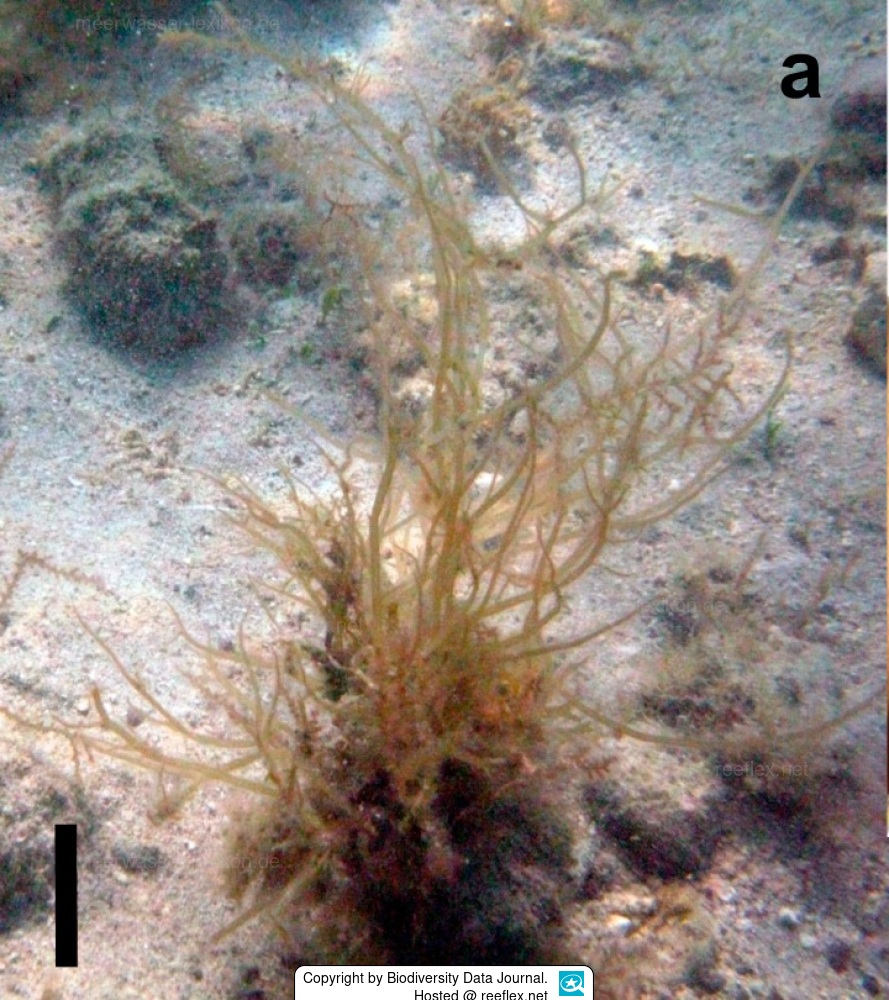Info
Gracilaria parvispora is a relatively fast-growing, finely branched red alga that is particularly suitable for algae refugia.
It is available from specialist retailers. Before introducing it into a reef aquarium, you should first check whether the algae is eaten by surgeonfish, as it is too expensive to use as a “salad snack”.
In the sea, Gracilaria parvispora occurs in areas with sand over rocky substrate with moderate water movement and lower light intensity.
The alga, which is called “Limu Ogo” in Hawaii, often shows a red coloration, but can become light brown, light green or almost white in light places.
Cultivation attempts in habitats with really very little water movement or in mariculture led to dark brown to almost black algae!
However, it is important that Gracilaria parvispora needs nutrient-rich water for good growth!
Since the alga is very popular for human consumption, it became quite abundant in Hawaii until it was overharvested, so that today the invasive alga Gracilaria salicornia dominates the typical natural habitats of Gracilaria parvispora on Oahu.
Recent studies have shown that mariculture of Gracilaria parvispora in floating baskets in the protected environment of traditional Hawaiian fish ponds yields high yields.
Gracilaria parvispora removes nutrients from seawater and supplies oxygen!
A very recent study examined hydrozoan epibionts of the red alga, which is significantly colonized by the following species:
Kirchenpaueria halecioides (Alder, 1859) formerly Ventromma halecioides (Alder, 1859)
Plumularia floridana Nutting, 1900
Clytia linearis (Thorneley, 1900)
Obelia cf. dichotoma
Obelia oxydentata Stechow, 1914
Obelia tenuis Fraser, 1938
Synonym: Gracilaria parvispora I.A.Abbott, 1985
Literature reference:
Mendoza-Becerril MA, Murillo-Torres P, Serviere-Zaragoza E, León-Cisneros K, Mazariegos-Villarreal A, López-Vivas J, Agüero J (2024)
First records of hydroid epibionts on the introduced macroalga Gracilaria parvispora in the Mexican Pacific.
Biodiversity Data Journal 12: e130248. https://doi.org/10.3897/BDJ.12.e130248
This is an open access article distributed under the terms of the Creative Commons Attribution License (CC BY 4.0), which permits unrestricted use, distribution, and reproduction in any medium, provided the original author and source are credited.
Synonym: Gracilaria parvispora I.A.Abbott, 1985
Literature reference:
Mendoza-Becerril MA, Murillo-Torres P, Serviere-Zaragoza E, León-Cisneros K, Mazariegos-Villarreal A, López-Vivas J, Agüero J (2024)
First records of hydroid epibionts on the introduced macroalga Gracilaria parvispora in the Mexican Pacific.
Biodiversity Data Journal 12: e130248. https://doi.org/10.3897/BDJ.12.e130248
This is an open access article distributed under the terms of the Creative Commons Attribution License (CC BY 4.0), which permits unrestricted use, distribution, and reproduction in any medium, provided the original author and source are credited.
It is available from specialist retailers. Before introducing it into a reef aquarium, you should first check whether the algae is eaten by surgeonfish, as it is too expensive to use as a “salad snack”.
In the sea, Gracilaria parvispora occurs in areas with sand over rocky substrate with moderate water movement and lower light intensity.
The alga, which is called “Limu Ogo” in Hawaii, often shows a red coloration, but can become light brown, light green or almost white in light places.
Cultivation attempts in habitats with really very little water movement or in mariculture led to dark brown to almost black algae!
However, it is important that Gracilaria parvispora needs nutrient-rich water for good growth!
Since the alga is very popular for human consumption, it became quite abundant in Hawaii until it was overharvested, so that today the invasive alga Gracilaria salicornia dominates the typical natural habitats of Gracilaria parvispora on Oahu.
Recent studies have shown that mariculture of Gracilaria parvispora in floating baskets in the protected environment of traditional Hawaiian fish ponds yields high yields.
Gracilaria parvispora removes nutrients from seawater and supplies oxygen!
A very recent study examined hydrozoan epibionts of the red alga, which is significantly colonized by the following species:
Kirchenpaueria halecioides (Alder, 1859) formerly Ventromma halecioides (Alder, 1859)
Plumularia floridana Nutting, 1900
Clytia linearis (Thorneley, 1900)
Obelia cf. dichotoma
Obelia oxydentata Stechow, 1914
Obelia tenuis Fraser, 1938
Synonym: Gracilaria parvispora I.A.Abbott, 1985
Literature reference:
Mendoza-Becerril MA, Murillo-Torres P, Serviere-Zaragoza E, León-Cisneros K, Mazariegos-Villarreal A, López-Vivas J, Agüero J (2024)
First records of hydroid epibionts on the introduced macroalga Gracilaria parvispora in the Mexican Pacific.
Biodiversity Data Journal 12: e130248. https://doi.org/10.3897/BDJ.12.e130248
This is an open access article distributed under the terms of the Creative Commons Attribution License (CC BY 4.0), which permits unrestricted use, distribution, and reproduction in any medium, provided the original author and source are credited.
Synonym: Gracilaria parvispora I.A.Abbott, 1985
Literature reference:
Mendoza-Becerril MA, Murillo-Torres P, Serviere-Zaragoza E, León-Cisneros K, Mazariegos-Villarreal A, López-Vivas J, Agüero J (2024)
First records of hydroid epibionts on the introduced macroalga Gracilaria parvispora in the Mexican Pacific.
Biodiversity Data Journal 12: e130248. https://doi.org/10.3897/BDJ.12.e130248
This is an open access article distributed under the terms of the Creative Commons Attribution License (CC BY 4.0), which permits unrestricted use, distribution, and reproduction in any medium, provided the original author and source are credited.







 Biodiversity Data Journal
Biodiversity Data Journal








